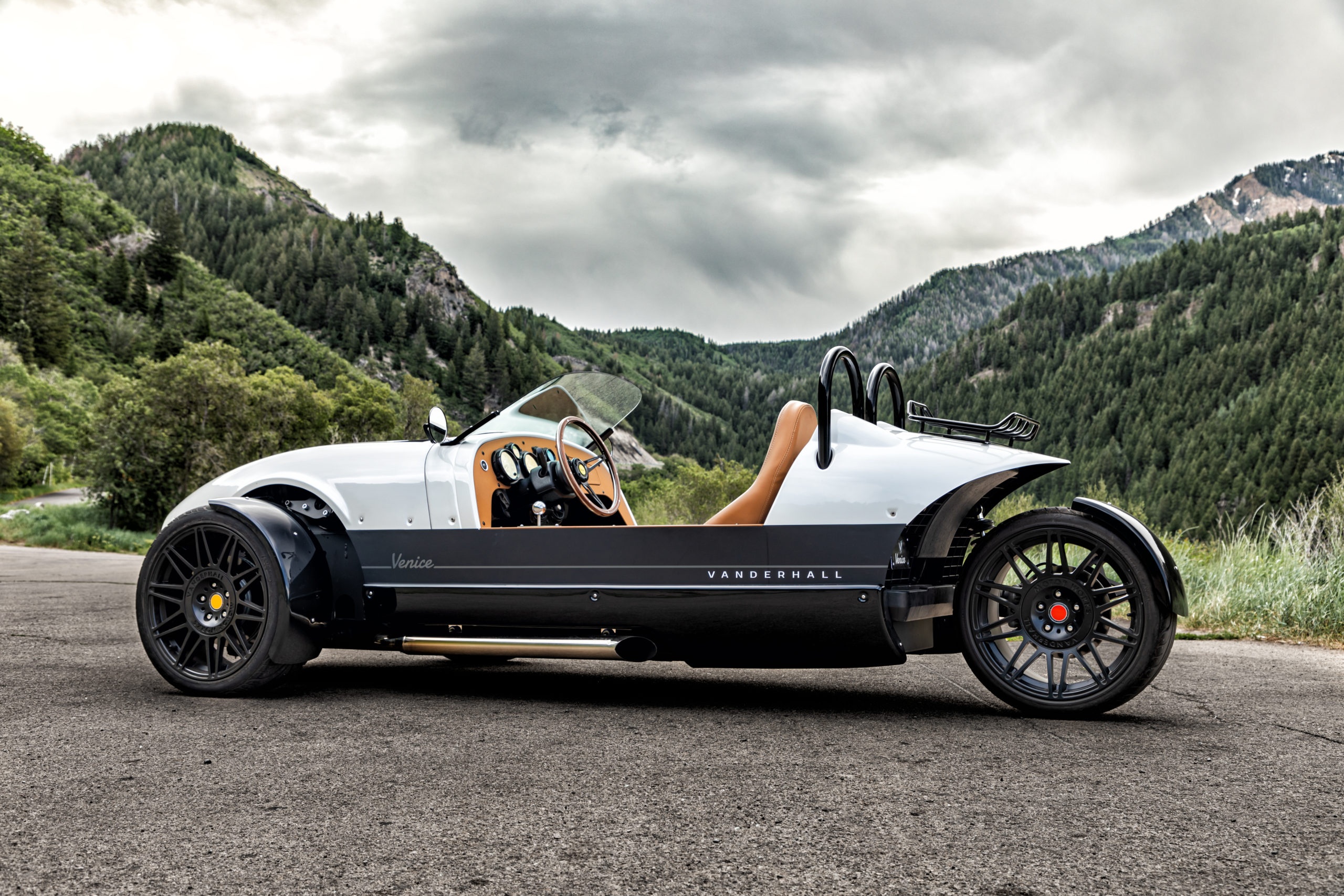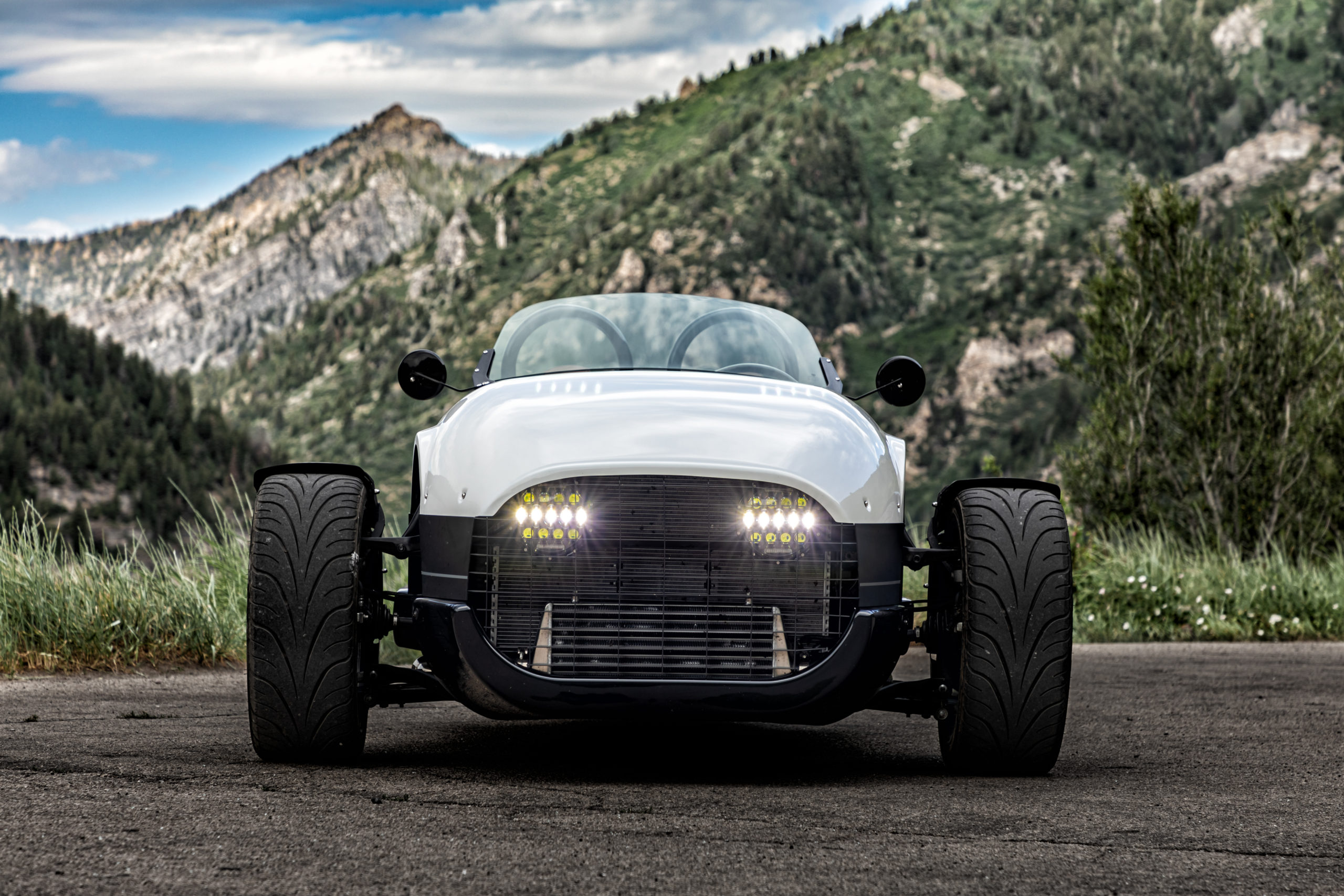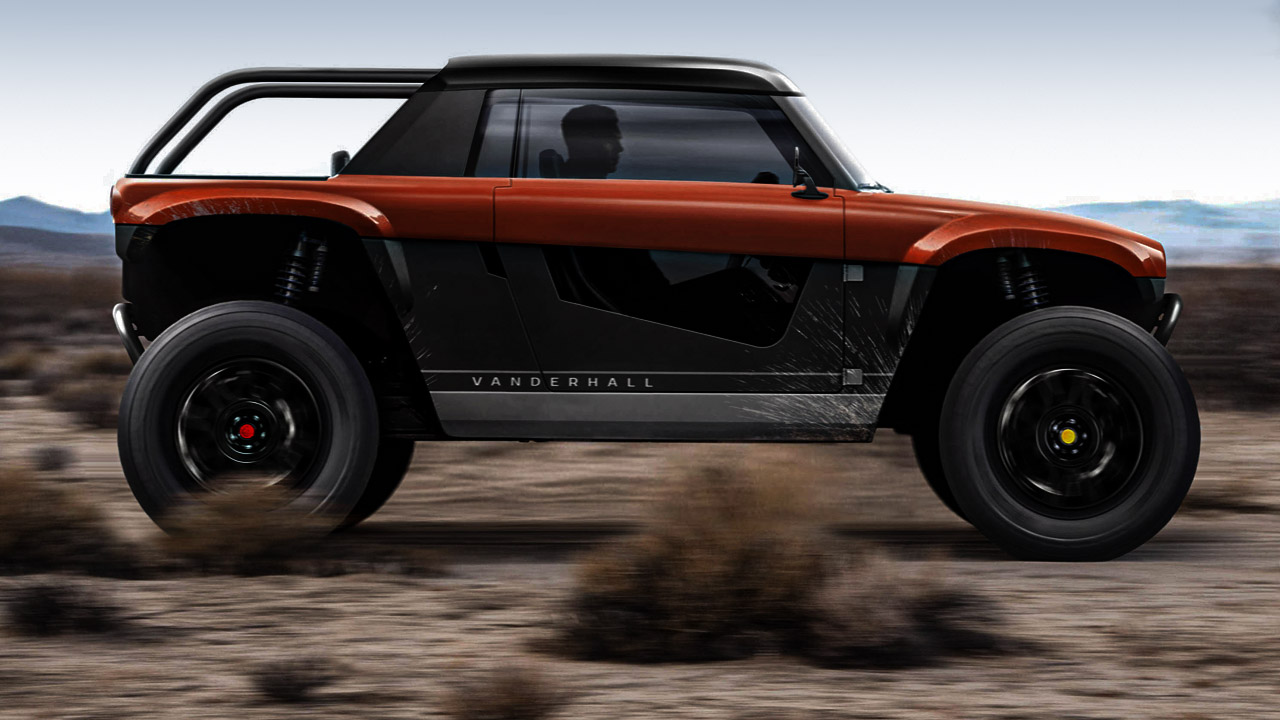
This company is re-imagining the motorcycle
P rovo, Utah is home to Vanderhall Motor Works—an innovative American vehicle manufacturer that’s building highly coveted three-wheel performance roadsters by hand. Their unique models are designed with sports driving, touring, commuting, and road cruising in mind.
“It’s a fantastic place for manufacturing,” says Steve Hall, founder and owner of Vanderhall, who has a mixed background in the automotive industry as a former CAD designer for Novatek. “It offers us close proximity to a wide variety of skilled workers, and there are opportunities to work with Provo city in a designated redevelopment zone. Plus there are business-friendly government relations here, and we’re surrounded by natural landscapes.”
Since the company’s conception 12 years ago, Vanderhall’s factory has experienced a significant evolution. 2010 was the year it all began—Vanderhall was born in a small corner of an auto dealership service bay. After two years of working out of the bay, Hall decided it was time to go all-in with his business venture. He sequestered half of the dealership’s showroom and built a wall down the middle to establish a design center where he could incubate his ideas.

Creating a new car from scratch
Initially, Hall wanted to enter the world of new vehicle sales by becoming the first US dealer of Noble Sports Cars from England, but the process of importing and undergoing homologation for street legal use empowered Hall with the background for this next enterprise. “The barrier to entry as a four-wheel fully homologated street legal vehicle is significant… such that very few new manufacturers survive the first 10 years of business,” he says. “Additionally, the design space is limited by regulatory requirements that truly pigeon-hole four-wheel creations into certain parameters (such as five-mile-per-hour bumpers and rollover ratings).”
Hall quickly realized that if they could build something that qualified as a motorcycle under federal regulations, both the initial barrier to entry and the design restrictions would be significantly mitigated. Hall began prototyping models for five years before designing, implementing, and launching a disruptive manufacturing process, as well as proving with sales the viability of his business—which, as Hall had imagined, showcased early potential for rapid growth.
A year later, Hall moved out of the converted automotive bay and tripled his square footage to a 20,000-square-foot facility, followed by a 60,000-square-foot facility in 2016, and an 80,000-square-foot facility in 2017. Today, the factory exists as a 200,000-square-foot factory, and it’s soon to be a 400,000-square-foot factory with the newest expansion that will open up by the end of 2020. This newest iteration will include an expansion of their current building to accommodate growth and output.
“Since the start, the transitions and in-between moments have always offered lessons for us in efficiency. Looking back, these times were telling of the explosive growth that the company has seen in its short 10-year existence,” says Hall.
Automotive companies often take decades to establish, so Vanderhall’s quick rise to success and the earned brand recognition has been something that’s come unexpectedly fast—but not without rigor and dedication. As a company, Vanderhall is considerably new in what’s called the “autocycle sector.” Their continuous release of limited edition roadsters embody an aesthetic that’s nostalgic of old-school cars, but with a merging of modern design when it comes to appearance.
From the Laguna to the Carmel, to the Speedster, and the Edison—all of their models have common, recognizable characteristics and features. Expect to experience a lot of metal, a lot of wind, a lot of noise, and no plastic or low-quality materials used in the building.
Once seated inside the car, there’s a surprising amount of space and comfort for what’s seemingly a very compact vehicle. Driving a Vanderhall car is truly about the experience. “It’s all about you against the elements, and it’s about allowing yourself the feeling of freedom that’s not available in a traditional car, while simply cruising down the road,” explains Hall.
“The key is that you need to be able to turn your back on ideas that did not make the cut. My Dad taught me that with his business. One day he visited one of our early facilities, I had some of our earlier iterations lined up against the wall and he recommended that I destroy them. He said: ‘You cannot look back or you will not be able to move forward.’ We destroyed them, and it made a lot of engineers mad, but it was the right thing to do.”
-Steve Hall
Consumers value these cars for that special feeling Hall describes, which was exactly why he decided to birth the company into existence. According to Hall, Vanderhall was founded with the main goal of “creating a car that would make people really smile when they sit down and drive.” The team went through a multitude of prototypes that took five years to master, before releasing their first model in 2016, the Laguna.
“The growth of Vanderhall was very steady the first five years,” Hall says. “It was all R&D. During this time we went through multiple prototypes before finally settling on the open-wheeled Laguna design, reminiscent of roadsters from the early days of motoring. This was also when we developed our matrix platform and manufacturing process which is truly what makes our company disruptive when compared to much larger OEM’s in the industry.”
This early edition, which is still available today, launched with a 1.4-liter, 200-horsepower GM four-cylinder engine that was turbocharged with a six-speed automatic transmission.

Adapting to consumer and market research
Five years ago, Vanderhall released its second car that was a simplified model of the Laguna in response to consumer and market research.
“In the fall of 2015, having settled on a final exterior design for the Laguna, Vanderhall hired some key personnel in engineering, sales, and marketing and released the product to the world at SEMA. The next year, 2016 saw healthy sales but exposed some supply chain bottlenecks. Data from sales also showed an opportunity to appeal to a broader audience if our target starting price could be under $30,000,” Hall says.
The Vanderhall team got to work in order to identify cost savings strategies, the largest of which was altering a manufacturing process used to make finished body panels (complete with paint). “Vanderhall’s application of the process was unique in that we were able to develop a way to manufacture our entire body, not just small components that other OEMs use the process for: thermal forming.
“Thermal forming our entire body components also enabled us to bypass paint as the finished exterior pigment was pre-infused into the carbon composite ABS panels from our supplier before we thermal formed into their final shape,” Hall says. Ultimately, this enabled Vanderhall to release an entry-level model, the Venice, that provided rapid acceptance of dealers for distribution.
From modest sales of over $1,000,000 in 2016, Vanderhall has more than doubled their numbers each year for 2017, 2018, and 2019. 2020, even with its unique challenges, is projected to closely align with sales of 2019, with gains year-over-year. This year also saw Vanderhall’s highest monthly sales numbers to date, with consumers flocking to recreational products in order to safely escape quarantine.
Over the years, Vanderhall has resisted becoming stagnant, which is likely why they’ve found such success. The company prides itself on continuous innovation in order to best suit the consumer marketplace. “In the beginning, the first restructuring came when the flagship model was not an effective draw for signing dealers, as its price point demanded an investment financially and physically that heightened perceived risks in taking on a new brand.
“By releasing the Venice, although sales consistently show a higher demand for the Carmel and likely a return of our Laguna, the entry-level price point of the Venice attracts both dealers and consumers to the brand,” Hall says.
In terms of design and finding solutions, iteration processes are a mainstay at Vanderhall. “The process is something like this: First we think of an idea. Second, we flesh the idea out with the R&D team. And third, we build one to see if it really has merit. Our matrix platform design and manufacturing process enables this by significantly lowering our cost to create and experience our ideas.
“The key is that you need to be able to turn your back on ideas that did not make the cut. My Dad taught me that with his business. One day he visited one of our early facilities, I had some of our earlier iterations lined up against the wall and he recommended that I destroy them. He said: ‘You cannot look back or you will not be able to move forward.’ We destroyed them, and it made a lot of engineers mad, but it was the right thing to do,” says Hall.
That same strong recognition for what works and what doesn’t has set the company apart. “Overall, we want the shape of a Vanderhall to embody a nostalgic nod to the motoring and aviation’s golden age—a time so glamorized and romanticized that just hopping in one of our roadsters mentality takes you back. It makes mundane tasks of running errands and turns them into adventures in their own right. It rekindles imaginative fantasies that fully grown, even mature adults find themselves drifting into on their way to pick up a gallon of milk. It reignites adolescent daydreaming and the joys of defining the mood of your day with the thoughts inside your head.”

Going electric (and off-road)
Currently, Vanderhall has a dealer network of 70 plus dealers in the US. They plan to at least double that number in the coming year to provide sales and service points sufficient to cover most US geographical locations.
Stores are also expanding rapidly abroad with European COC being approved last year. Australia and other right-hand drive countries will come along shortly, as Vanderhall plans to continue adding countries as their production expands its capacity. Today, they are selling 70 to 80 percent in the US, but projections show that will likely flip to the reverse over time.
The future looks bright for Vanderhall, as they have plans to expand even further into the power sports realm, starting with their upcoming release, the Navarro. The electric Edison model took several years to bring into production. When they launched, the combination of instant torque, horsepower, and a product that was more designed for discretionary use rather than utility proved to become a perfect marriage.
“The ‘unplug and play’ design capabilities are limitless with a car like this. So our next launch will be electrifying the Powersports realm in a manner that we think will drive a revolution. It takes some time to bring the ‘roll coal’ crowd. But once they experience the power packaging an EV can deliver, we feel even they will be converted. Hence our announcement on our off-road adventure vehicle, the Navarro,” Hall says.
“The notion of road escape is always intriguing and alluring. But in today’s current climate, Vanderhall cars are speaking to consumers, perhaps now more than ever.”
-Steve Hall
“We have an on-road-discretionary use offering in our roadsters models, and we have shown our cards with our off-road Navarro. Insights into the future can be gleaned by the patents we have been granted for land, marine, and air.”
It’s only natural that Vanderhall has big plans to continue expanding their premiere brand by ultimately enabling a one-stop-shop for a variety of sporting vehicles. “Without revealing confidential plans, it’s Vanderhall’s intention to develop a variety of products that will be our brand’s answer to consumer demand for a wide variety of Powersports products and companion products,” Hall says.
While Vanderhall does not release production numbers, their current sales are exceeding their own production abilities. With their latest factory expansion about to open and the production of the Navarro coming, they’re looking forward to a busy year in 2021.
“The notion of road escape is always intriguing and alluring,” Hall says, “But in today’s current climate, Vanderhall cars are speaking to consumers, perhaps now more than ever.”





